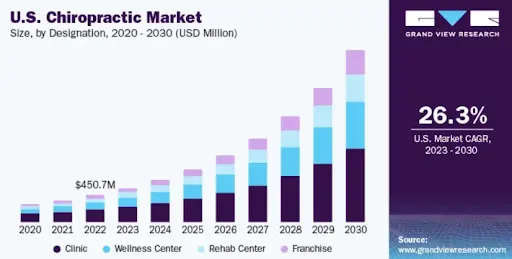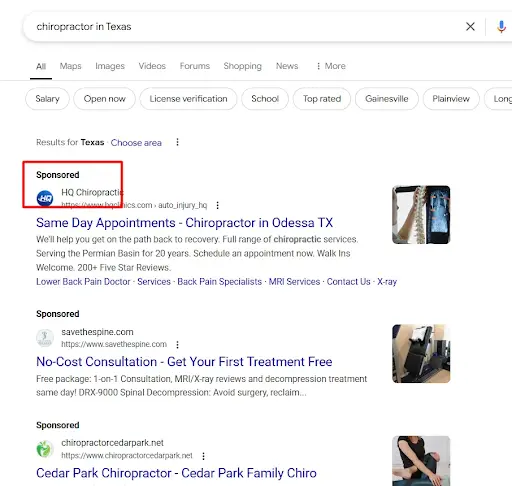Cyber Monday Offer is Here! Subscribe by December 5 to Get 3 Months Free!
Learn More
Table of Contents

Experience Better Practice Management Today!
Starting at $28.05/month
No Credit Card Required

Experience Better Practice Management Today!
Starting at $30/month
No Credit Card Required
Expanding your chiropractic practice can feel overwhelming when your focus is on caring for patients instead of marketing. But without a plan, it’s easy to blend into the background and miss chances to grow.
In this guide, I’ll share 12 proven strategies around:
The U.S. chiropractic industry is projected to reach $28.71 billion by 2030, with a growth rate of 26.3% between 2023 and 2030. That growth brings opportunity, but it also means more competition. The clinics that stand out and connect with the right patients will be the ones that thrive.

These strategies are practical, simple to follow, and designed to help you grow your practice without feeling like you’re running a second full-time job. Let’s get started.
Getting noticed and bringing in new patients isn’t just about being good at what you do, it’s also about reaching the right people with the right approach. To make it easier, we’ve organized these 12 marketing strategies for chiropractors into three clear categories:
Before launching any marketing activity, it’s essential to understand your local audience and what sets your chiropractic clinic apart. Many chiropractors serve competitive neighborhoods where standing out requires more than just being available. These first steps will help you clarify your message and position yourself effectively in your local area.
Every chiropractic practice serves different groups. Some focus on athletes, others on families or older adults. Your marketing should speak directly to the people you want to attract.
Here are a few audience types and how to reach them:
Once you’ve identified your target groups, shape your messages around what matters most to each, whether it’s convenience, pain relief, long-term mobility, or family-focused care.
Before finalizing your marketing approach, it’s smart to review what other chiropractic clinics in your area are doing. Tools like Google Maps, Yelp, and local directories can help you compare their services, ratings, and visibility.
Here’s how to use competitor insights to your advantage:
Use competitor reviews and listings as a shortcut to see what patients are already saying, and use that insight to position your clinic as the smarter choice in your area.
Local SEO ensures people in your area can easily find your chiropractic clinic online, especially when they search for services nearby.

These steps build trust with both search engines and potential patients, helping your practice show up where it matters most, right in front of people nearby looking for care.
You can also check out this blog on local SEO strategies with examples of schema markup, local keywords and much more for chiropractors.
Now that you’ve laid the groundwork, it’s time to expand your reach with digital marketing strategies. Pairing these tactics with an all-in-one chiropractic software solution can help you attract and manage patients more efficiently while growing your practice.
Your website is often a new patient’s first impression. If it's slow, confusing, or outdated, they’re likely to move on to another provider.
Here’s what every chiropractor’s site should include:
If you don’t have a website yet, platforms like Noterro offer a simple way to launch one with customizable templates tailored for chiropractors.
Pro Tip:
Once your website is up and running, consider creating a clinic-branded app to enhance the patient experience. A dedicated app makes appointment scheduling, communication, and accessing resources seamless, improving patient satisfaction and retention. Happy patients are more likely to spread positive word-of-mouth, helping you attract even more clients.
Bonus read: How to Maximize Your Practice Growth with Chiropractic Scheduling Software
Paid advertising is one of the fastest ways to reach people who are actively looking for a chiropractor. With a small daily budget of just $10 to $20, you can start testing what works and drive more traffic to your website.
Start with these two platforms:

Important: Always direct your ad clicks to a specific landing page that matches the ad’s message. Avoid sending users to your homepage.
Besides, you can test different ad headlines to see what gets the best response. So, for example, you add these examples like “Same-Day Appointments,” “Drug-Free Back Pain Relief,” etc., in your ad copies and see which works best.
You should also track results and gradually increase your ad budget on the versions that bring in the most new patients.
Many people hesitate to visit a chiropractor because they’re unsure what to expect, or whether it’s the right solution for their pain. Educational content helps answer these questions, builds confidence, and positions your clinic as a trusted source of care.
Use these formats to reach and educate potential patients:
Example: “5 Signs You Might Need a Chiropractor (and When to Book an Appointment)”
Helpful read: 5 Ways Chiropractors are Earning More With Booking Software
Educational content not only improves your presence in search results, but it also earns patient trust before they walk through your door.
Social platforms like Facebook, Instagram, and TikTok give chiropractors a direct way to connect with their community and highlight what sets their care apart. These channels help your clinic feel more accessible and familiar, especially for those new to chiropractic treatment.
What to post:

Posting regularly and engaging with comments builds familiarity and trust, two key drivers in helping people choose you when they’re ready to book.
Also read: How to Turn Your Chiropractic Clinic into a Patient Magnet
Email marketing is one of the simplest and most reliable ways to stay in touch with both new and returning patients. It keeps your practice top of mind, builds familiarity, and encourages repeat visits.
Here’s how to use it effectively:
By sending thoughtful, targeted emails, you can strengthen relationships with your patients and make it easier for them to book with you again.
You May Also Like: 16 Practice Management Software Features Chiropractors Shouldn’t Ignore
Digital strategies are powerful, but offline methods still play a vital role in connecting with your local community.
Hosting or participating in local events gives you a direct way to meet potential patients and show them the value of chiropractic care in a relaxed, personal setting. These face-to-face interactions help build awareness and trust, both key to long-term patient growth.
Try these local outreach ideas:
Referral partnerships are a practical way to bring in new patients while supporting other professionals in your community. By building connections with providers who offer services that complement yours, you create a steady, long-term pipeline of patient referrals.
Strong referral relationships not only increase patient traffic, but they also enhance your reputation as part of a reliable care network, which builds trust with new and existing patients alike.
While digital marketing dominates, printed materials still work well, especially when reaching people in your immediate area. Flyers, brochures, and postcards are great for raising awareness and encouraging appointments from nearby residents. Here’s how to use print marketing effectively:
Print materials make your practice visible in daily routines and are especially helpful for those who may not actively be searching online but are open to learning more.
Your online reputation directly affects how patients view your practice. Reviews not only shape first impressions but also influence whether someone decides to book with you. By managing feedback actively, you can strengthen trust and attract more patients.
Here’s how to make reviews work for you:
Negative reviews are inevitable, but your response can make all the difference. Address complaints promptly and empathetically, showing that you value patient feedback and are committed to resolving issues.
A response like, “Thank you for your feedback. We’re sorry about your experience and would like to address your concerns. Please contact us directly so we can make things right,” demonstrates your dedication to patient satisfaction.
A smart marketing plan starts with knowing how much to spend and where. A common guideline for chiropractors is to invest 7–10% of their annual revenue into marketing. This mix should support both long-term growth and short-term visibility.
These low-cost methods take time but help build trust and search visibility.
Use tools like Google Analytics or chiropractic-specific marketing software to measure what’s working. Monitor clicks, bookings, and new patient sources regularly so you can shift budget toward the strategies that bring the best return.
Marketing doesn’t have to feel like a burden. With the right mix of local SEO, content, community outreach, and referrals, you can steadily bring in new patients and stay visible in your area.
The key is consistency. Simple efforts like sharing tips on social media, hosting a local event, or asking for feedback build momentum over time. Start with one or two strategies that fit your schedule, measure what works, and keep refining.
As your clinic grows, the admin can easily pile up. That’s where Noterro helps. From booking and billing to charting and patient apps, everything is in one place, so you spend less time on paperwork and more time caring for patients.
The demand shifts throughout the year, and so does the marketing. For example, desk-related pain spikes after holiday breaks, while sports injuries rise in summer. So, tailoring campaigns to seasons will improve relevance.
Yes. You can create your own templates to match your style of practice. Whether you focus on deep tissue, sports rehab, or prenatal care, you can adjust note sections, add custom tags, and include images to suit the treatment.
There are some common pitfalls that you need to look out for when enhancing your marketing efforts. It includes spreading efforts and budgets too thin, ignoring follow-up with past patients, not measuring results, and relying only on word-of-mouth without scalable strategies.
Yes, paid ads on Google and social media target high-intent patients quickly. Start small, track results, and scale as you see success.
Stand out by highlighting specialized services like prenatal, pediatric, or sports care, while keeping your Google Business Profile current with photos, reviews, and service details. Pair this with community events or wellness workshops to showcase your expertise and build trust locally.
Track patient inquiries, appointment bookings, and website visits regularly. Use tools like Google Analytics or your practice software to identify what channels are driving growth.
Review it quarterly. Assess what’s working, what needs improvement, and adjust based on seasonality, patient behavior, or business goals.
Retention directly supports acquisition; happy patients refer to friends and family. Focusing on patient experience can reduce the need for heavy ad spend.
Tags



